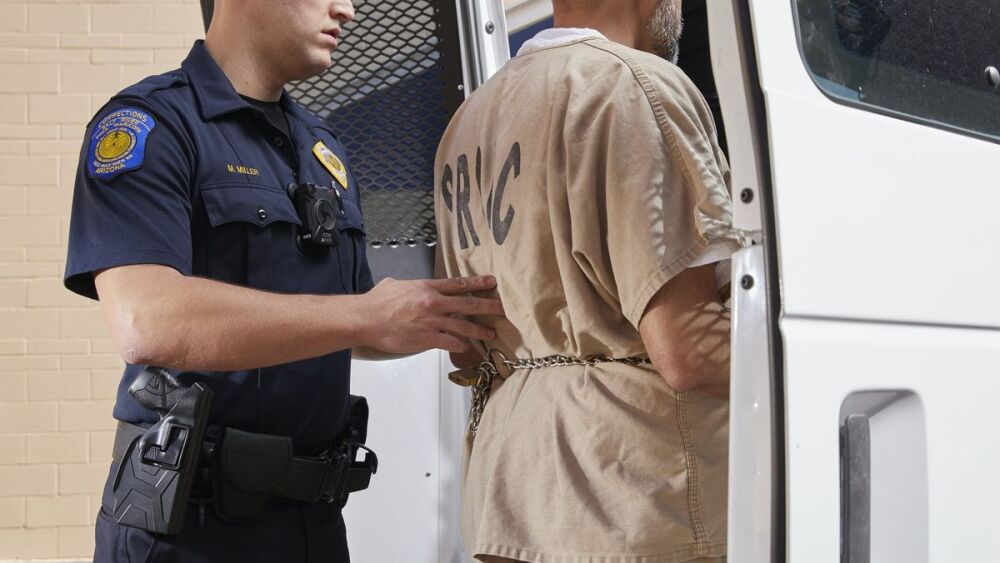Sponsored by Axon
By Corrections1 BrandFocus Staff
Whether in a bus, van, ambulance or car, transporting inmates is one of the riskiest functions in corrections. As they are being moved from one secure facility to another, inmates may act up at any stage of the transport or even try to escape, putting themselves, corrections officers and the public at risk.
Live video surveillance of inmate transports is an effective way for corrections officials to identify escape attempts and other forms of inmate misbehavior, and to dispatch assistance promptly as required.
But when it comes to live video surveillance, fixed video cameras mounted within vehicles cannot match the level of coverage, detail and information captured by web-connected body-worn cameras. In this article, we explore four key benefits provided by bodycams during inmate transport that fixed cameras cannot match.
1. Better coverage inside and outside the vehicle
Bodycams are mobile, providing greater flexibility and coverage than fixed cameras at all stages of inmate transport. Bodycams see whatever the officer sees, including the restraint process and what happens both inside and outside the transport vehicle.
“A fixed camera on a transport bus or in a van is a substantial improvement over not having any cameras at all, but it cannot compare to the visuals delivered by a bodycam,” said Brad Livingston, retired executive director of the Texas Department of Criminal Justice. “With a bodycam, you can see all phases of the transport from start to finish.”
The end-to-end documentation provided by bodycams eliminates any gaps in fixed camera coverage that can occur at smaller facilities, especially public buildings where surveillance is not a priority.
“For instance, you may be bringing an offender into a small regional hospital that doesn’t have all the surveillance cameras needed for full coverage,” said Richard Roy, consultant and retired New York State Department of Corrections deputy commissioner/inspector general. “In situations like these, the only way to achieve this coverage is by having your officers wear bodycams.”
2. Better accountability for everyone
By covering every stage of inmate transport, bodycams provide unimpeachable evidence of what transpired. This video record makes it easy to hold officers and inmates accountable for their actions during transport, with no gray areas or opportunities for doubt after the fact.
Also, bodycams can, by their presence alone, provide a deterrent. People who know they are being observed and recorded on video tend to act better than those not under observation. This is why bodycams can enhance officer and inmate safety during transport.
“If the inmate acts up, the bodycam video will tell the truth about what really happened,” said Roy. “As a result, officers wearing bodycams may serve as a deterrence factor when it comes to inmates acting up during transfers.”
3. Bodycams function in the background
Corrections officers on transport duty must be hyper-vigilant, which means they don’t need any unnecessary distractions. Officers have no time to fuss with a piece of electronic equipment when their attention needs to be focused on the inmates being transported and their behavior – along with the physical circumstances of their immediate surroundings and every other aspect associated with inmate transport from start to end.
Bodycams function in the background, which makes life easier for corrections officers. They just have to clip the cameras on their uniforms, turn them on, and then forget about these devices until the end of shift.
This convenience reduces demands on officers’ situational awareness during routine inmate transports while improving their safety and on-the-job documentation. Bodycams also help out during extraordinary events such as mass disaster evacuations, when corrections officers are transporting entire prison populations out of harm’s way and cannot afford any distractions whatsoever.
“When hurricanes are projected to hit certain locations along the Texas coast, there’s a decision point for the corrections agencies where they choose to evacuate one or multiple facilities,” said Livingston. “When you have that many offenders on the road at the same time, bodycams can do their jobs without demanding officers’ attention so that they can concentrate on the inmates in their charge.”
4. Bodycams keep command staff informed
The combination of GPS tracking and live video streams available with a connected bodycam system means that commanders know where their officers are at all stages of inmate transport, as well as what is happening during that transport. This eliminates any sudden unpleasant surprises. If one or more inmates acts up, command can see what is transpiring as it happens and react accordingly.
“This combination of GPS tracking and live video streams can make bodycams a game-changer when it comes to effectively managing inmate transports,” said Livingston. “Knowing what is happening inside and outside a prison bus, van, car or ambulance in real time enhances everybody’s safety and minimizes the chance for escape attempts to spiral out of control.”
A proven technology
The four bodycam benefits listed above are not news to the nation’s police departments. Many have been using bodycams for years and consistently receiving these benefits as a result.
In contrast, corrections has been slow to adopt bodycams. But this trend is finally taking hold, says Livingston.
“From a state corrections perspective, I believe bodycams are just now gaining momentum and moving, I hope, rapidly,” Livingston said. “Certainly, I think the positive bodycam experience that law enforcement has had to date, with the enhancement of safety and surveillance and accountability, is now being experienced by corrections in a few locations. And a lot more will be added soon.”
Corrections has a long way to go, agrees Roy, but he believes the industry will get there sooner rather than later.
For more information, visit Axon.
Read Next: 6 things bodycams can do that fixed cameras can’t












